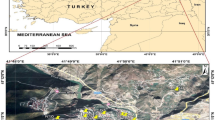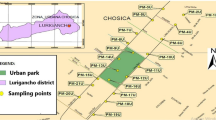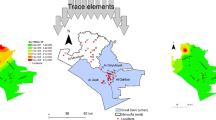Abstract
Introduction
In this study, olive tree leaves, collected from 50 sampling sites throughout the Province of Aydın, Turkey, were used to estimate level of pollution by measuring Al, As, B, Ba, Ca, Co, Cr, Cu, Fe, K, Li, Mg, Mn, Na, Ni, Pb, Sr, and Zn concentrations and calculating pollution factor (PF) values.
Materials and methods
After sample preparation, collected leaves were microwave digested, and extracts were analyzed by an inductively coupled plasma-mass spectrometer.
Results and discussion
The maximum PF values were ≥10 for a number of elements ranging from 11–13 (Al, As, Cr, Fe, Mn, Ni) to >100 for Cu, Li, and Na. Urban–rural and roadside–nonroadside concentration comparisons showed that some of the elements (As, Cu, and Pb) were at significantly higher levels on urban and/or roadside sampling sites.
Summary and conclusion
Correlations and factor analysis showed that there may be common sources for some elements, which included several soil types and anthropogenic activities. Based on the results of the statistical source apportionment, possible sources were narrowed down with help of the constructed elemental concentration maps. In conclusion, utilization of olive tree leaves for biomonitoring and assessment of environmental pollution was shown to be possible in the Mediterranean region where they are indigenous and cultivated.




Similar content being viewed by others
References
Aghabarati A, Hosseini SM, Maralian H (2008) Heavy metal contamination of soil and olive trees (Olea europaea L.) in suburban areas of Tehran, Iran. Res J Environ Sci 2:323–329
Al-Khlaifat AL, Al-Khashman OA (2007) Atmospheric heavy metal pollution in Aqaba city, Jordan, using Phoenix dactylifera L. leaves. Atmos Environ 41:8891–8897
Cetin B, Yatkin S, Bayram A, Odabasi M (2007) Ambient concentrations and source apportionment of PCBs and trace elements around an industrial area in Izmir, Turkey. Chemosphere 69:1267–1277
Çelik A, Kartal AA, Akdoğan KY (2005) Determining the heavy metal pollution in Denizli (Turkey) by using Robinio pseudo-acacia L. Environ Int 31:105–112
Çinar T, Elik A (2002) Determination of heavy metals in bio-collectors as indicator of environmental pollution. Int J Environ Anal Chem 82:312–329
Dogan Y, Durkan N, Baslar S (2007) Trace element pollution biomonitoring using the bark of Pinus brutia (Turkish red pine) in the Western Anatolian part of Turkey. Trace Elem Electrolytes 24:146–150
Elik A, Akçay M, Sökmen M (2000) Ultrasonic leaching of bio-collectors for heavy metal analysis. Int J Environ Anal Chem 77:133–145
Farooqi A, Masuda H, Siddiqui R (2009) Sources of arsenic and fluoride in highly contaminated soils causing groundwater contamination in Punjab, Pakistan. Arch Environ Contam Toxicol 56:693–706
Fogg TR, Rahn KA (1984) Boron as a tracer of aerosol from combustion of coal. Geophys Res Lett 11:854–857
Giraud EP, Klaver G, Negrel P (2009) Natural versus anthropogenic sources in the surface- and groundwater dissolved load of the Dommel river (Meuse basin): constraints by boron and strontium isotopes and gadolinium anomaly. J Hydrol 369:336–349
Gratani L, Crescente MF, Varone L (2008) Long-term monitoring of metal pollution by urban trees. Atmos Environ 42:8273–8277
Howe P, Malcolm H, Dobson S (2004) Manganese and its compounds: environmental aspects. World Health Organization, Geneva
Houhou J, Lartiges BS, Pelletier EM, Sieliechi J, Ghanbaja J, Kohler A (2009) Sources, nature, and fate of heavy metal-bearing particles in the sewer system. Sci Total Environ 407:6052–6062
Madejon P, Maranon T, Murillo JM (2006) Biomonitoring of trace elements in the leaves and fruits of wild olive and holm oak trees. Sci Total Environ 355:187–203
Maisto G, Alfani A, Baldantoni D, De Marco A, De Santo AV (2004) Trace metals in the soil and in Quercus ilex L. leaves at anthropic and remote sites of the Campania Region of Italy. Geoderma 122:269–279
Pacyna JM, Pacyna EG (2001) An assessment of global and regional emissions of trace metals to the atmosphere from anthropogenic sources worldwide. Environ Rev 9:269–298
Pöykiö R, Peramaki P, Niemela M (2005) The use of Scots pine (Pinus sylvestris L.) bark as a bioindicator for environmental pollution monitoring along two industrial gradients in the Kemi-Tornio area, northern Finland. Int J Environ Anal Chem 85(2):127–139
Rossini Oliva S, Mingorance MD (2006) Assessment of airborne heavy metal pollution by aboveground plant parts. Chemosphere 65:177–182
Schulz H, Popp P, Huhn G, Stark HJ, Schüürmann G (1999) Biomonitoring of airborne inorganic and organic pollutants by means of pine tree barks. I. Temporal and spatial variations. Sci Total Environ 232:49–58
Tomasevic M, Vukmirovic Z, Rajsic S, Tasic M, Stevanovic B (2005) Characterization of trace metal particles deposited on some deciduous tree leaves in an urban area. Chemosphere 61:753–760
Tuna AL, Yağmur B, Hakerlerler H, Kılınç R, Yokaş İ, Bürün B (2005) Muğla Bölgesindeki Termik Santrallerden Kaynaklanan Kirlilik Üzerine Çalışmalar. Scientific Research Project Report. Muğla, Turkey: Muğla University
Tuncel SG, Yenisoy-Karakas S, Dogangün A (2004) Determination of metal concentrations in lichen samples by inductively coupled plasma atomic emission spectroscopy technique after applying different digestion procedures. Talanta 63:273–277
Vaccaro S, Sobiecka E, Contini S, Locoro G, Free G, Gawlik BM (2007) The application of positive matrix factorization in the analysis, characterization and detection of contaminated soils. Chemosphere 69:1055–1063
Yatkin S, Bayram A (2008a) Source apportionment of PM10 and PM2.5 using positive matrix factorization and chemical mass balance in Izmir, Turkey. Sci Total Environ 390:109–123
Yatkin S, Bayram A (2008b) Determination of major natural and anthropogenic source profiles for particulate matter and trace elements in İzmir, Turkey. Chemosphere 71:685–696
Yay OD, Alagha O, Tuncel G (2008) Multivariate statistics to investigate metal contamination in surface soil. J Environ Manage 86:581–594
Yoshinaga J, Kida A, Nakasugi O (2001) Statistical approach for the source identification of boron in leachates from industrial landfills. J Mater Cycles Waste Manage 3:60–65
Wang X, Sato T, Xing B (2006) Size distribution and anthropogenic sources apportionment of airborne trace metals in Kanazawa, Japan. Chemosphere 65:2440–2448
Zhang XY, Lin FF, Wong MTF, Feng XL, Wang K (2009) Identification of soil heavy metal sources from anthropogenic activities and pollution assessment of Fuyang County, China. Environ Monit Assess 154:439–449
Acknowledgment
Olive leaves were collected by Duygu Ates in a research project supported by the Scientific and Technical Research Council of Turkey (Grant No. 107O170). We thank Environmental Research Center of İzmir Institute of Technology for the microwave digestions and the ICP-MS analysis.
Author information
Authors and Affiliations
Corresponding author
Additional information
Responsible editor: Henner Hollert
Rights and permissions
About this article
Cite this article
Turan, D., Kocahakimoglu, C., Kavcar, P. et al. The use of olive tree (Olea europaea L.) leaves as a bioindicator for environmental pollution in the Province of Aydın, Turkey. Environ Sci Pollut Res 18, 355–364 (2011). https://doi.org/10.1007/s11356-010-0378-z
Received:
Accepted:
Published:
Issue Date:
DOI: https://doi.org/10.1007/s11356-010-0378-z




